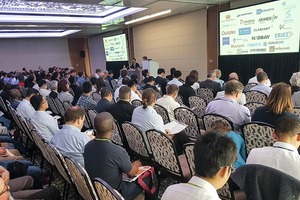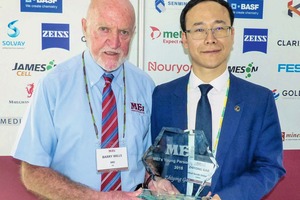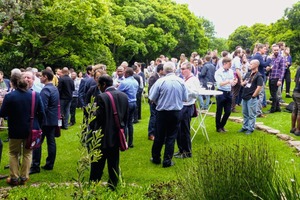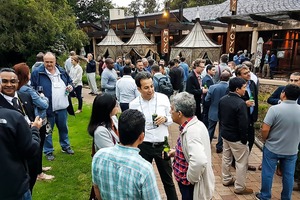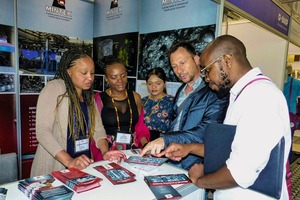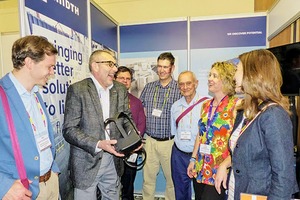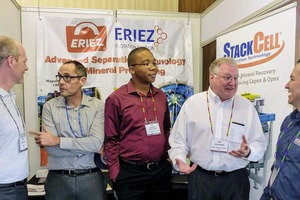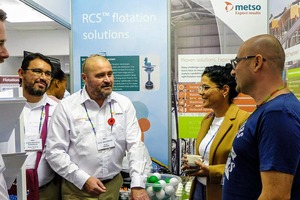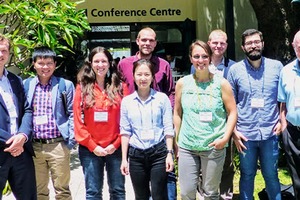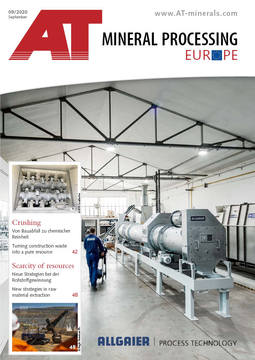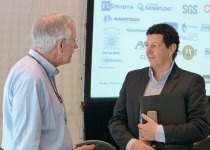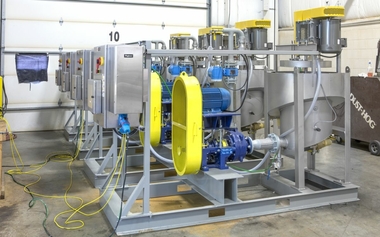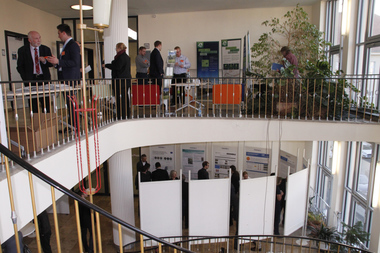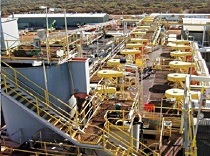Basics and application areas
The keynote lecture in the fundamentals symposium was held by J. Ralston (University of South Australia/Australia). He recalled the scientific legacy of Joseph Kitchener and its impact in flotation and colloid science. The keynote lecture in applications symposium was held by J.E. Nesset (NesseTech Consulting Services Inc. and Adjunct Professor, McGill University/Canada). He talked about history of flotation and Canadian contributions to research and flotation practice. Amongst other that were column flotation and continuous mini pilot plant, which has been invented in 1922 already.
Sea or process water
S.K. Solongo (Conbuk National University/South Korea) investigated cationic collector conformations onto oxide minerals with the aim to understand mechanisms of adsorption by using seawater or circuit water. N.P. Mhonde (Aalto University/Finland) tried a simultaneous approach to assess the combined effect of water temperature and complex water matrices on xanthate adsorption on chalcopyrite and pentlandite. L.L. October (University of Cape Town/South Africa) presented improvements of an automated contact time apparatus to research particle-bubble-attachment time of chalcopyrite and galena depending on water quality. Yanhong Wang (Central South University/China) showed that the negative effects of clays in copper flotation can be cured by saline water. G.P.W. Suyantara, (Kyushu University/Japan) investigated the effect of seawater on bubble interactions with chalcopyrite and molybdenite surfaces. T. Vargas (Universidad de Chile/Chile) presented results of testworks where bacteria Acidothiobacillus ferrooxidans were used as depressant on Cu-activated pyrite in seawater flotation which lead to a reduction in lime consumption. The presentation of I. Muzinda (Aalto University/Finland) outlines investigations of the impacts of various aspects of water quality on performance of a comminution and flotation plant. In applications symposium T. Bhambhani (Solvay Mining Solutions/USA) reported on the impact of aqueous species and fine colloidal matter in process water on flotation performance at Rio Tinto Kennecott’s Copperton Concentrator.
Flotation reagents
D. Pienaar (University of Cape Town/South Africa) talked on the interactions of thiol collectors with frothers on pyrite, quartz, and chalcocite. E. Schach (Helmholtz Institute Freiberg for Resource Technology/Germany) investigated the mechanism of the nitrile based sulfide collector Tecflote. This collector was also tested in rougher-scavenger flotation at Boliden Aitik, Sweden. The results were presented by Odair Lima (Nouryon/Sweden). Zhiyong Gao (Central South University/China) tested a new collector for the separation of galena and sphalerite from pyrite, which showed good results on selectivity compared with xanthate. T. Nuorivaara (Aalto University/Finland) replaced polyglycolether by naturally based reagents and improved froth stability and tolerance against changes in operation. C.H. Veloso (Université de Lorraine/France and ArcelorMittal Global Research & Development/France) was focusing on low grade iron ores and Fe-bearing-silicates with complex mineralogy, where amine type collectors were tested. N. Kupka (Helmholtz Institute Freiberg for Resource Technology/Germany) talked on potential role of colloidal silica as a calcite depressant in scheelite flotation. Jianyong He (Central South University/China) gave insights into the adsorption mechanism of gallic acid/ pyrogallic acid/tannic acid on calcium-bearing mineral surfaces. In applications symposium C.A. Young (Montana Technological University/USA) presented the successful implementation of alternate organic depressant to NaSH in chalcopyrite-molybdenite flotation. The flotation behaviour of malachite with a chelating collector was investigated by X.R. Zhang, (BGRIMM Technology Group/China). R. Hartmann (Aalto University/ Finland) employed hexyl amine cellulose nanocrystals as collector replacing amines in the flotation of quartz. A novel automated contact timer apparatus was also tested to analyse the mineral´s floatability. S. Engelbrecht (Clariant Southern Africa (Pty) Ltd/South Africa) reported on two cases where new Clariant products achieved high recoveries in gold and copper from ores with high aluminosilicate content. D. Chipfunhu (BASF/Australia) presented novel flotation reagents for the beneficiation of spodumene. B. Fletcher (University of Queensland/Australia) compared native starch, oxidized starch and carboxy methyl cellulose (CMC) as depressants at copper-activated pyrite flotation.
Minerals and mines
L. Chun-feng (Beijing Research Institute of Chemical Engineering and Metallurgy/China) studied the surface characteristics and flotation mechanism of pitchblende and uraninite. T. Moimane (University of Queensland/Australia) worked on a better understanding of the sulfidization process of oxidised copper sulphides. G.P.W. Suyantara (Kyushu University/Japan) presented a selective oxidisation by hydrogen peroxide followed by improved floatability of arsenic bearing minerals. Two presentations on cobalt bearing minerals showed the increasing importance of cobalt for electromobility. R. Kuyvenhoven (Sustainable Minerals Institute/Chile) presented results from the exploration of a potential coppermine where cobalt could be found associated with pyrite. Q. Dehaine (Camborne School of Mines/UK and Geological Survey of Finland/Finland), investigated mixed oxidised and suilphidized Cu-Co-ores and presented a new strategy for enriching the Co-minerals. R. Jolsterå (Loussavaara-Kiirunavaara AB/Sweden) investigated how changes in pulp chemistry and flotation circuit design can minimize impurities at flotation of apatite from mine tailings. M. Rudolph (Helmholtz-Institute Freiberg for Resource Technology/Germany) presented first results on recovering graphite and valuable metals from spent lithium ion batteries by flotation. R.G. Merker (Merker Mineral Processing/Germany), presented a flotation regime where the rare earth elements containing mineral parisite could be concentrated up to 40 % REO at a high recovery.
Phase interfaces and bubbles
K. You (Korea Institute of Geoscience and Mineral Resources/South Korea) correlates the interaction force between solid surface and bubble with contact angle measurements. M. Eftekhari (TU Dresden/Germany) investigated the processes on bubble surfaces as well as the flow field around the bubble and how this was influenced by submicron particles and surfactants. Liguang Wang (University of Queensland/Australia) showed how oscillating aeration influences the bubble size in a column flotation cell. K. Heiskanen (Aalto University/Finland) studied some aspects related to the viscoelastic properties of the bubble surfaces and the approach velocity of bubbles that effect the coalescence. S. Farrokhpay (University of Lorraine/France) produced fine bubbles by a microbubble generator. This improves flotation of fine particles.
Influence of grinding
M. Peltoniemi (University of Oulu/Finland) compared mineralogical and surface characteristics of flotation feed and products after wet and dry grinding and could show clear differences on surface properties.
PEPT Positron Emission Particle Tracking
During fundamentals symposium there were several talks on the use of Positron Emission Particle Tracking (PEPT) for investigatons on flotation hydrodynamics: In the first talk on this issue A.-E. Sommer (Institute of Fluid Dynamics/Germany), investigated the influence of microturbulence on the bubble-particle interaction. P.R. Brito-Parada (Imperial College/UK) presented a work on Pulp-froth interface phenomena investigated with PEPT. K. Cole (University of Cape Town/South Africa and Imperial College/UK), describes the flow profile of a laboratory scale flotation vessel and quantifies the turbulent fluctuating velocity experienced by hydrophobic and hydrophilic tracer particles. And last not least A.J. Morrison (University of Queensland/Australia), applied PEPT on an Eriez HydroFloat covering with this some preliminary work for implementation of modeling of fluidised bed flotation
Fine particles and entrainment
S. Arriagada (Federico Santa Maria Technical University/Chile) presented a new approach for flotation of fine particles by using hydrophobized hollow glass microspheres. T. Bhambhani (Solvay and Columbia University/USA) presented on the effect of particle size and shape which was investigated on mica entrainment mechanism.
Modeling
A novel flotation recovery model that includes CFD-computed turbulence intensity on particle-bubble collision efficiency was presented by G. Evans (University of Newcastle/Australia). J. Yianatos (UTFSM/Chile) presented a new approach for flotation process modelling and simulation based on industrial data from modern and large flotations cells (up to 300 m³). P. Vallejos (UTFSM/Chile) presented simulation results using USM-FLotmod for different flotation cells and bench arrangements with the aim to predict an optimum arrangement. K. Runge (JKMRC/Australia) showed first results on development of a semi-empirical model of the HydroFloatCell which is based on a hindered settling classification model with variation of buoyancy of the particle-bubble aggregates.
Flotation operation
Y. Ghorbani (Luleå University of Technology/Sweden) examined the current knowledge on the effect of low temperature on flotation performance in order to identify suitable flotation reagents/reagent regimes and hydrodynamic concepts which could be adapted to mineral processing and tailing treatment in cold climate. M. Safari (University of Cape Town/South Africa) investigated the effect of physical parameters on iron ore flotation in mechanical flotation cells. J.J. Frausto (Metso Minerals/Canada) presented on the development of a reagents scheme for copper and zinc sulphides in the presence of pyrrhotite and hard water at the polymetallic skarn deposit in Mineras Sabinas (Mexico). The impact of grinding chemistry on sulphide and oxide copper mineral flotation at the Lubumbe Mine/Zambia was the focus of C.J. Greet’s (Magotteaux Australia Pty Ltd/Australia) presentation. He showed that flotation performance could be improved by using high chromite grinding media. S. Xu (University of South Australia/Australia) investigated the effect of stockpile oxidation and oxidation of fresh particle surfaces during grinding on the floatability of pure pyrite particles. The importance of a contact angle distribution concept rather than average contact angle of particles in flotation studies was highlighted.
Flotation equipment
S. Morgan (Outotec/Australia) presented the flotation performance optimisation by customising launder configuration and rotor type. This is useful for changing ore conditions. S.C. Chelgani (Luleå University of Technology/Sweden) talked on the effects of mechanical cell height on grade and recovery. S.J. Neethling (Imperial College/UK) asked an interesting question: Is there a maximum size for an efficient flotation cell? He emphasizes that with bigger volumes there will be a transition from determination of cell performance by kinetics to bubble carrying capacity. A theoretical model for this transition was presented. G.J. Jameson (University of Newcastle/Australia) presented test results on flotation of chalcopyrite 0 – 1.4 mm in a fluidized bed with additional separate outlet for coarse particles. The presentation was accompanied by a theory to predict critical conditions for a loaded bubble to pass into the froth. V. Ross (Mintek/South Africa) presented test results on the use of hydrodynamic cavitation devices (HCDs) to improve the recovery of valuable mineral from fine and oxidised PGM ore. In a second presentation he presented a novel, pneumo-mechanical flotation cell where flotation kinetics, recovery and selectivity in PGM and chromite flotation could be improved. J.E. Dickinson (University of Newcastle/Australia) used a new Reflux Flotation Cell pilot skid to perform tests in production plants for copper ore and coal. J. Suhonen (Outotec/Finland), presented results on measuring of gas dispersion and other parameters in a 630-m³-cell and comparing the results to values from other cell sizes. Yihong Yang (BGRIMM Technology Group/China) evaluated hydrodynamics and metallurgical performance of the actally largest flotation cell in world (680 m³). D. Lelinski (FLSmidth/USA) introduced the newWEMCOnextGen™ flotation mechanism and the philosophy for retrofit into existing WEMCO® flotation machines. V. Lawson (Glencore Technology/Australia) demonstrated improvements in gold and base metal flotation performance using a Jameson Cell. A. Weber (Eriez/USA) presented an industrial application of the high-intensity StackCell flotation technology. The cell consists of decoupled bubble-particle-contact zone and separation zone. D. Mesa (Imperial College/UK) showed how impeller design improves froth stability. L.O. Filippov (Université de Lorraine/France and National University of Science and Technology/Russia) presented test results of potash flotation using sonication. The selectivity between KCl and NaCl improves. This was attributed to the increased detachment of weak hydrophobic NaCl particles. R. Melville (Roytec/South Africa) presented same level arrangement of flotation cells using slurry-suction impellers.
Process control and automatization
Z. Ertekin (Hacettepe University/Turkey) presented a newly developed stainless steel electrode modified by gold for the electrochemical detection of thiosulfates in water in the presence of sulfates. Z.C. Horn (Stone Three Digital/South Africa) presented a framework for froth state classification using available online measurements of cell operation (pulp level, aeration rate, etc.) together with variables inferred from flotation froths e.g. froth height, bubble size, and froth velocity. T. Bertsch (Festo AG & Co. KG/Germany) reported on applying digitalization and artificial intelligence concepts in minerals processing on the example of level control by dart valves. M. Ferra (REXA Inc./USA) presented the advantages of electro-hydraulic actuators by replacing pneumatic actuators. J.J. Anes (Flottec LLC/Canada) presented first results of a study of the interactions of gas holdup, gas superficial velocity, froth level and frother dosage with recoveries of Pb and Ag in a lead rougher flotation cell. This study describes the initial phase of a project aimed at developing a practical application of hydrodynamic concepts to control metallurgical performance in a plant. M. Tenhunen (Timegate Instruments Oy/Finland) talks on time-gated Raman spectroscopy as an powerful real-time process for monitoring concentration and mineralogical information in slurries and froth.
Author:
Irina Bremerstein, UVR-FIA GmbH Freiberg/Germany

